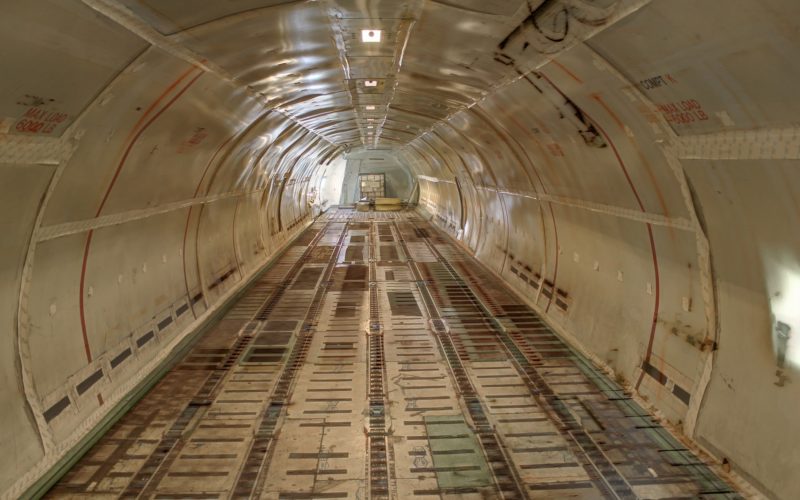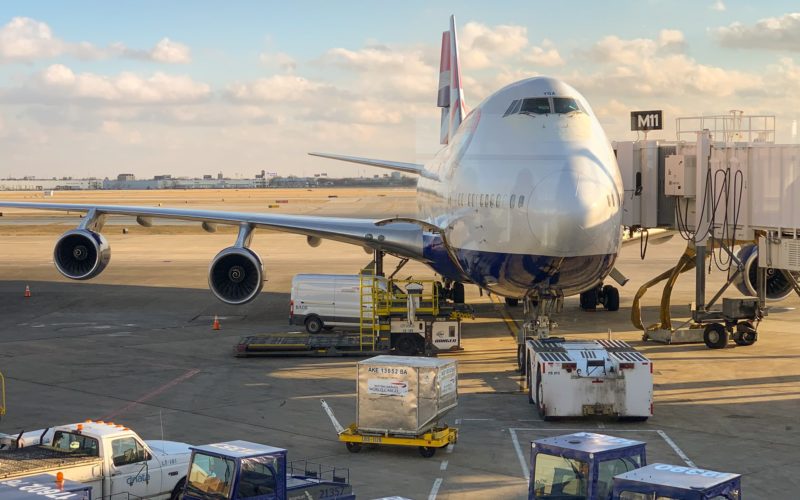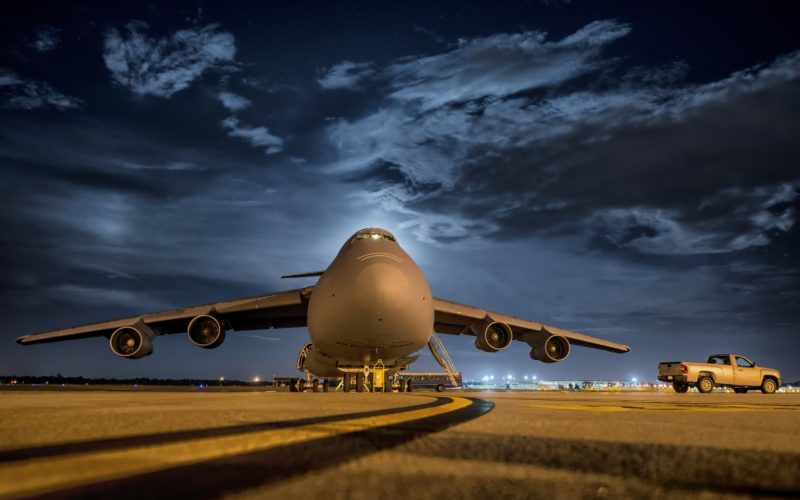Click the according title to display information

Container Specification
Standard Containers
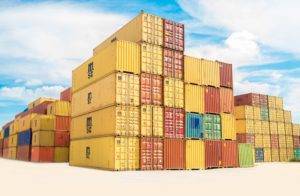
General purpose cargo container
Standard (or General Purpose) containers are the most common type of freight container, manufactured from either aluminium or steel they are built to withstand the rough conditions found at sea.
Standard containers or general purpose containers are the most used type of freight containers for all types of general cargo, closed on all four sides they can be supplied with doors at one or both ends and one or both sides depending on the requirements. 20ft and 40ft are the most common container size although they are available in a wide range of other sizes such as; 10ft, 30ft, 45ft and even 53ft from specialist suppliers.
The standardization of cargo containers is regulated by the International Organization for Standardization (ISO) and this ensures containers can be stacked most efficiently, literally one on top of another. Although freight containers are manufactured around the world they are built to specific ISO specifications to enable the efficient and easy intermodal transportation of goods across the globe.
Containers are also available specially designed for certain types of cargo such as ‘garmentainers’ which are standard containers fitted with string, a bar system or a combination of both, these containers are designed to hold garments neatly and allow for increased flexibility and load capacity meaning savings on transportation and handling costs.
Standard Container Specifications
| Specifications | 20ft Standard Container | 40ft Standard Container |
|---|---|---|
| Max. Gross Weight | 30.480kg (67.200lb) | 32.500kg (71.650lb) |
| Tare Weight | 2.350kg (5.180lb) | 3.910kg (8.620lb) |
| Max. Payload | 28.130kg (62.020lb) | 28.590kg (63.030lb) |
| External Dimensions: | ||
| Length | 6.06m (19´10.5″) | 12.19m (40´00″) |
| Width | 2.44m (8´00″) | 2.44m (8´00″) |
| Height | 2.59m (8´6″) | 2.59m (8´6″) |
| Internal Dimensions: | ||
| Length | 5.90m (19´04″) | 12.03m (39´06″) |
| Width | 2.35m (7´08″) | 2.35m (7´08″) |
| Height | 2.39m (7´10″) | 2.39m (7´10″) |
| Door Opening: | ||
| Width | 2.34m (7´8.1″) | 2.34m (7´8.1″) |
| Height | 2.28m (7´5.4″) | 2.28m (7´5.4″) |
| Cube: | ||
| Cube Capacity | 33.1 m3 (1.170 ft3) | 67.7 m3 (2.390 ft3) |
Photo by frank mckenna on Unsplash
High Cube Containers

Stackable container with increased volume
High Cube containers provide an extra foot in height compared to standard containers, they are ideal for the shipment of light, voluminous or bulky cargoes.
High cube containers are very similar to standard containers with one main difference; high cube containers have a height of 9’6″ as opposed to 8’6″ on standard shipping containers. This extra available height makes these freight containers ideal for light, voluminous cargo and bulky cargo.
High Cube Container Specifications These ocean containers are constructed to meet the high demands of sea travel, built from steel or aluminium they are strong, secure and weather proof allowing for the safe transportation of goods across the globe using intermodal transportation.
High Cube Container Specifications
| Specifications | 20ft High Cube Container | 40ft High Cube Container |
|---|---|---|
| Max. Gross Weight | 30.480kg (67.200lb) | 32.500kg (71.650lb) |
| Tare Weight | 2.350kg (5.180lb) | 3.910kg (8.620lb) |
| Max. Payload | 28.130kg (62.020lb) | 28.590kg (63.030lb) |
| External Dimensions: | ||
| Length | 6.06m (19´10.5″) | 12.19m (40´00″) |
| Width | 2.44m (8´00″) | 2.44m (8´00″) |
| Height | 2.90m (9´6″) | 2.90m (9´6″) |
| Internal Dimensions: | ||
| Length | 5.90m (19´04″) | 12.03m (39´06″) |
| Width | 2.35m (7´08″) | 2.35m (7´08″) |
| Height | 2.70m (8’10”) | 2.70m (8’10”) |
| Door Opening: | ||
| Width | 2.34 m (7´08″) | 2.34 m (7´08″) |
| Height | 2.58 m (8´05″) | 2.58 m (8´05″) |
| Cube: | ||
| Cube Capacity | 37.30 m3 (1,317 ft3) | 76.2 m3 (2,690 ft3) |
Image courtesy of https://containertech.com/articles/40-standard-vs-40-high-cube-container
Open Top Containers
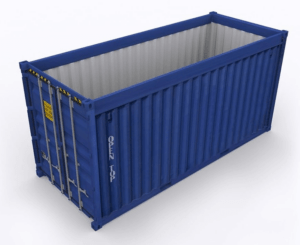
Tarpaulin roof to allow easy loading/ unloading
Open Top containers have no solid roof and instead use tarpaulin to cover the container, this structural feature significantly simplifies the process of packing and unpacking the container.
Open top containers do not have solid roofs instead they have removable bows and a weatherproof tarpaulin roof which can be secured with ropes and allows for a significantly simplified loading and unloading process, the door header may also be swung out allowing for easier access to the cargo. Open top containers are ideal for bulky cargo such as machinery.
Open Top Container Specifications The removable bows on open top containers are not there solely to hold the tarpaulin cover but also to add stability to the ocean container, therefore flat rack containers can be more suited to over height cargoes.
Lashing rings in the container are used to secure and prevent shifting of the cargo during transit; these lashing rings can hold loads of up to 1,000kg.
Open Top Container Specifications
| Specifications | 20ft Open Top Container | 40ft Open Top Container |
|---|---|---|
| Max. Gross Weight | 30.480kg (67.200lb) | 30.480kg (67.200lb) |
| Tare Weight | 2.350kg (5.180lb) | 4.000kg (8.820lb) |
| Max. Payload | 28.130kg (62.020lb) | 26.480kg (58.380lb) |
| External Dimensions: | ||
| Length | 6.06m (19´10.5″) | 12.19m (40´00″) |
| Width | 2.44m (8´00″) | 2.44m (8´00″) |
| Height | 2.59m (8´6″) | 2.59m (8´6″) |
| Internal Dimensions: | ||
| Length | 5.90m (19´04″) | 12.03m (39´5.2″) |
| Width | 2.35m (7´08″) | 2.35m (7´08″) |
| Height | 2.37m (7´9.3″) | 2.37m (7´9.3″) |
| Door Opening: | ||
| Width | 2.34m (7´8.3″) | 2.34m (7´8.3″) |
| Height | 2.28m (7´5.4″) | 2.28m (7´5.4″) |
| Cube: | ||
| Cube Capacity | 32.8 m3 (1.158 ft3) | 66.9m3 (2.363 ft3) |
Image courtesy of https://www.thincke.com/how-to-measure-the-liquid-level-of-the-iso-tank-container
Refrigerated Containers
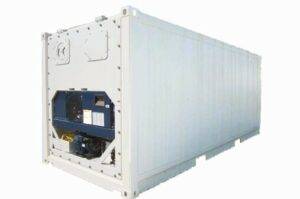
Cargo container for temperature controlled goods
Refrigerated (or Reefer) containers are used for the transportation of goods requiring a temperature controlled environment such as: fruit, meat and dairy products.
Refrigerated containers (also known as reefer containers) are used when certain goods, such as; fruit, flowers, vegetables, meat and dairy products need to be transported at a constant low temperature. Refrigerated containers have a fully integral refrigeration machine which is capable of holding internal temperatures between +25 & -25 degrees centigrade. They are available as 20ft and 40ft containers designed to ISO regulations.
Refridgerated Container Specifications When refrigerated containers are at freight terminals they are connected to the terminals power supply, whilst travelling on a vessel the containers are connected to the ships power supply system, alternatively they can be fitted with ‘power packs’ which use diesel generators to power the cooling system, these generators are also used when the container is being transported by road or rail.
Refrigerated containers can also be equipped with hook rails which meat and other goods can be neatly hung from.
Refrigerated containers are also available as high cube refrigerated containers.
Refrigerated Container Specifications
| Specifications | 20ft Refrigerated Container | 40ft Refrigerated Container |
|---|---|---|
| Max. Gross Weight | 30,480kg (67,200 lb) | 32,500kg (71,650 lb) |
| Tare Weight | 3,000kg (6,610lb) | 4,920kg (10,846lb) |
| Max. Payload | 27,480kg (60,590lb) | 27,480kg (60,803lb) |
| External Dimensions: | ||
| Length | 6.05m (19′-10″) | 2.192m (40′-0″) |
| Width | 2.43m (8′-0″) | 2.43m (8′-0″) |
| Height | 2.59m (8′-6″) | 2.59m (8′-6″) |
| Internal Dimensions: | ||
| Length | 5.45m (19′-10″) | 11.57m (37′-11″) |
| Width | 2.29m (8′-0″) | 2.29m (8′-0″) |
| Height | 2.59m (8′-6″) | 2.59m (8′-6″) |
| Lashings/ Bottom Rail | 4 Pieces/ Side, 6 Pieces/ Side | 6 Pieces/ Side |
| Loading Line (Height) | 2.19m (7′-2″), 2.15m (7’3/4″) | 2,457 mm (8′) |
| Door Opening: | ||
| Width | 2.29m (7′-6″) | 2.29m (7′-6″) |
| Height | 2.26m (7′-5″) | 2.26m (7′-5″) |
| Cube: | ||
| Cubic Capacity | 28.4m3 (1,017 ft.3) | 59.8 m3 (2,111.8 ft.3) |
Image courtesy of https://www.meeberg.com/fr/rebuild-open-top-containers/dry-boxes/20ft-reefer-container/
Flat rack Containers
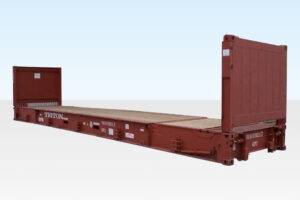
High load capacity container with collaspable walls
Flat Rack containers have a high load capacity and are ideally suited to oversized, heavy lift cargoes such as unboxed machinery and construction equipment.
Flat rack containers are most often used as either 20ft or 40ft containers, they are ideal for large and heavy cargoes which cannot be loaded into containers with fixed sides or walls. Flat rack containers have a high load capacity frame and a softwood floor, the walls at either end of a flat rack can be fixed or collapsible.
Flat Rack Container Specifications The end walls on a flat rack container provide more than sufficient stability for them to be stacked on top of each other and lashing rings found in the side rails, floor and corner posts allow for the cargo to be safely secured, these lashing rings help to accommodate loads of up to 2000 kg, in the case of 20’ flat racks, and 4000 kg in the case of 40’ flat racks.
Many 20ft flat rack containers are provided with forklift pockets and 40ft flat racks have gooseneck tunnels at both ends.
Flat Rack Container with Collapsable End WallsFlat rack containers can also be supplied with lashing winches & lashing belts of 2 metric tons and, depending on the type of cargo, stanchions may also be provided.
Flat Rack Container Specifications
| Specifications | 20ft Flat Rack Container | 40ft Flat Rack Container |
|---|---|---|
| Tare Weight | 3,100kg (6,835 lb) | 6,646kg (12,450 lb) |
| Max. Cargo | 20,015kg (44, 133 lb) | 30,476kg (67,200 lb) |
| Dimensions | ||
| Length | 5.85 m (19′-19″) | 12.05m (39′-52″) |
| Width | 2.23 m (7′-31″) | 2.12m (6′-95″) |
| Height | 2.15 m (7′-04″) | 1.96m (6′-43″) |
Image courtesy of https://www.portablespace.co.uk/product/40ft-x-8ft-used-shipping-container-flat-rack
Platform Containers
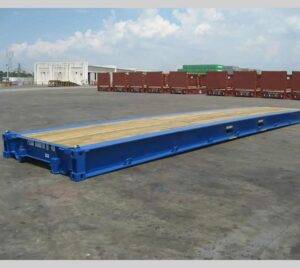
Flat container used for heavy lifts and project cargoes
Platform containers have an extreamly high load capacity and because of this are often used for oversized, awkward project cargoes for which other freight container types are not sufficient.
Platform containers are available as 20ft and 40ft platforms and compromise of a reinforced base without side or end walls. The flatbed structure is built from wood with a steel frame and has an extremely high loading capacity which makes it possible to concentrate heavy weights on small areas.
Platform Container Specifications Platform containers are ideally suited to oversized, heavy load and awkward project cargoes which cannot be transported in other container types such as high cube or open top containers. 40ft platform containers have lashing rings for securing cargo of up to 3,000kg in the side rails and gooseneck tunnels at each end.
Platform containers can be lashed together to create a larger platform for oversized and heavy loads which exceed the standard platform container specifications.
Platform Container Specifications
| Specifications | 20ft Platform Container | 40ft Platform Container |
|---|---|---|
| Tare Weight | 2,750kg (6.061lb) | 5,800kg (12,783lb) |
| Max. Cargo | 24,000kg (52,896lb) | 39,200kg (86,397lb) |
| Dimensions | ||
| Length | 6.085m (19’11”) | 12.90m (40’00”) |
| Width | 2.438m (8’00”) | 2.40m (8’00”) |
| Height | 2.233m (7’04”) | 1.95m (6’5″) |
Image courtesy of https://cargostore.com/40ft-platform-flat-rack-iso/
Tank Containers

Cylindrical container with frame to allow stacking
Tank containers are used for the transportation of bulk liquids and gases. They are designed and built to international regulations for the transportation of various classes of hazardous & non hazardous cargoes.
Tank containers are used for the shipment of gases or liquids, they are often used for the transportation of hazardous cargoes such as fuel and toxic substances. Tank containers must be filled to a minimum of 80% capacity and must not exceed 95% capacity, this is to allow sufficient ullage space for thermal expansion whilst preventing dangerous surging of the liquids in transit.
Tank Container Specifications Approximately 95% of tank containers are built to 20ft specifications although they are also available as 10ft, 30ft, 40ft and 45ft containers. The ISO frame allows for these tank containers to be shipped using modern inter-modal shipping options which include container ships, rail lines and trucks. This flexibility provides a safe, reliable and cost-effective way to transport such cargoes to locations across the globe.
Tank Container Specifications
| Specifications | 20ft Tank Container |
|---|---|
| Max. Gross Weight | 30,480kg (67,200lb) |
| Tare Weight | 4,190kg (9,237lb) |
| Max. Payload | 26,290kg (57,959lb) |
| External Dimensions | |
| Length | 6.05m (19′-10″) |
| Width | 2.43m (8′-0″) |
| Height | 2.59m (8′-6″) |
Image courtesy of https://www.thincke.com/how-to-measure-the-liquid-level-of-the-iso-tank-container

